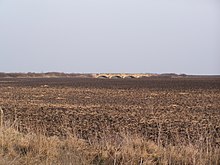Beba Veche
Beba Veche
Óbéba | |
|---|---|
 | |
 Location in Timiș County | |
| Coordinates: 46°8′N 20°19′E / 46.133°N 20.317°E | |
| Country | Romania |
| County | Timiș |
| Government | |
| • Mayor (2020–2024) | Ioan Bohăncanu[1] (PSD) |
| Area | 94.04 km2 (36.31 sq mi) |
| Elevation | 80 m (260 ft) |
| Population (2021-12-01)[3] | 1,328 |
| • Density | 14/km2 (37/sq mi) |
| Time zone | EET/EEST (UTC+2/+3) |
| Postal code | 307035–307037 |
| Vehicle reg. | TM |
| Website | www |
Beba Veche (Hungarian: Óbéb; German: Altbeba; Serbian: Стара Беба, romanized: Stara Beba) is a commune in Timiș County. It is composed of three villages: Beba Veche (commune seat), Cherestur and Pordeanu. Beba Veche is the westernmost settlement in Romania.
Geography
Located in the eastern part of the
Climate
Beba Veche is dominated by a moderate
History
Beba Veche is one of the oldest settlements in Banat. Archaeological discoveries have led Swabian historiographer Felix Milleker to conclude that it dates back to the Stone Age.[6] Judging by the tumuli discovered here, it can be said that it dates at least from the time of the Agathyrsi (6th century BC).[7] Historian Nicolae Ilieșiu claims that until the 5th century, it was called Vitoliu, after the name of the Roman emperor Vitellius.[7]
The first document attesting Beba Veche dates from 1247, during the reign of Béla IV of Hungary. It was mentioned as Béb in a chronicle preserved at the Museum of History in Cluj-Napoca.[8] The settlement was originally owned by the Csanád clan; the name comes from one of the family members.[9] At the end of the 13th century, due to repeated attacks of the Cumans, the village was depopulated.[9] According to the Turkish census of 1557–1558, only 15 houses inhabited by Hungarians were registered in the settlement.[9] In 1647, Rascian shepherds began to settle here, but they did not stay here for a long time either.[9] After the Treaty of Passarowitz and the establishment of Austrian rule in Banat, it seems that Beba Veche was no longer inhabited, because on Mercy's map from 1723 to 1725, Beba is no longer mentioned.[6]

In 1773, the
After the establishment of the Austro-Hungarian dualism in 1867, the administration of the commune was ensured by the servants of the Court. Among other things, the loss of the cultural identity of the Romanians in the commune was sought, by imposing the Hungarianization of the name and surname.[10] This lasted until after World War I. Towards the end of the 19th century and the beginning of the 20th century, many inhabitants emigrated to America, and some of them returned with important capitals, helping economic development.
After World War I, according to the
Demographics
Ethnic composition (2011)[12]
Beba Veche had a population of 1,539 inhabitants at the 2011 census, down 4% from the 2002 census. Most inhabitants are
| Census[14] | Ethnic composition | ||||
|---|---|---|---|---|---|
| Year | Population | Romanians | Hungarians | Germans | Roma |
| 1880 | 4,576 | 1,838 | 2,212 | 507 | – |
| 1890 | 4,930 | 2,018 | 2,366 | 491 | – |
| 1900 | 5,065 | 2,126 | 2,461 | 437 | – |
| 1910 | 4,182 | 1,854 | 1,819 | 417 | – |
| 1920 | 1,039[a] | 66 | 918 | 34 | – |
| 1930 | 4,009 | 1,649 | 1,864 | 359 | 49 |
| 1941 | 3,655 | 1,452 | 1,721 | 351 | – |
| 1956 | 2,766 | 1,156 | 1,370 | 175 | 22 |
| 1966 | 2,427 | 1,092 | 1,161 | 134 | 1 |
| 1977 | 2,142 | 988 | 985 | 90 | 41 |
| 1992 | 1,625 | 898 | 640 | 19 | 47 |
| 2002[15] | 1,600 | 979 | 567 | 19 | 30 |
| 2011 | 1,539 | 951 | 498 | 20 | 18 |
Economy

The main area of the economy is
In 2007, in the commune of Beba Veche, there were 14 firms with a turnover of 2,401,875 lei, which places Beba Veche within the communes with a low degree of economic development.[16]
Notes
- ^ Data on the populations of Battyánháza, Beba Veche and Cherestur missing
References
- ^ "Results of the 2020 local elections". Central Electoral Bureau. Retrieved 16 June 2021.
- ^ "Informații generale". Primăria comunei Beba Veche.
- ^ "Populaţia rezidentă după grupa de vârstă, pe județe și municipii, orașe, comune, la 1 decembrie 2021" (XLS). National Institute of Statistics.
- ^ Ghinea, Dan (2000). Enciclopedia geografică a României (2nd ed.). Editura Enciclopedică. p. 127.
- ^ a b c d e f Comloșan, Denisa Amelia; Dincu, Ana Mariana; Mănescu, Camelia Maria (2017). "A monographic analysis of Beba Veche, Timiș County, Romania". Lucrări Științifice. 19 (3): 227–232.
- ^ a b Lotreanu, Ioan (1935). Monografia Banatului. Timișoara: Institutul de Arte Grafice "Țara".
- ^ ISBN 973-7608-65-8.
- ^ Szabó, M. Attila (2003). Erdély, Bánság és Partium történeti és közigazgatási helységnévtára. Miercurea Ciuc: Pro-Print Kiadó.
- ^ a b c d e f Borovszky, Samu (1912). Magyarország vármegyéi és városai. Budapest: Országos Monográfia Társaság.
- ^ a b "Istorie". Primăria comunei Beba Veche.
- ISBN 973-675-278-X.
- ^ a b "Tab8. Populația stabilă după etnie – județe, municipii, orașe, comune". Institutul Național de Statistică. Archived from the original on 2016-01-18. Retrieved 2021-09-04.
- ^ a b "Tab13. Populația stabilă după religie – județe, municipii, orașe, comune". Institutul Național de Statistică. Archived from the original on 2020-08-07. Retrieved 2021-09-04.
- ^ Varga, E. Árpád. "Temes megye településeinek etnikai (anyanyelvi/nemzetiségi) adatai 1880-1992" (PDF).
- ^ "Beba Veche / Óbéb / Altbeba". Structura etno-demografică a României. Centrul de Resurse pentru Diversitate Etnoculturală.
- ^ a b "Comuna Beba Veche". Enciclopedia României.



